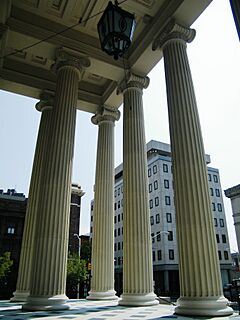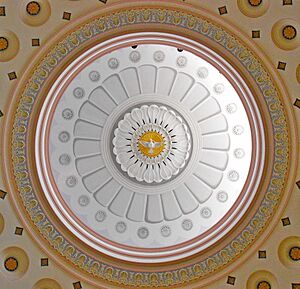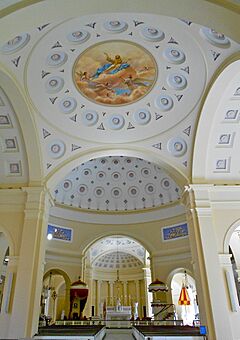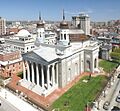Basilica of the National Shrine of the Assumption of the Blessed Virgin Mary facts for kids
Quick facts for kids Baltimore Basilica |
|
|---|---|
| Basilica of the National Shrine of the Assumption of the Blessed Virgin Mary | |
| "America's First Cathedral" | |
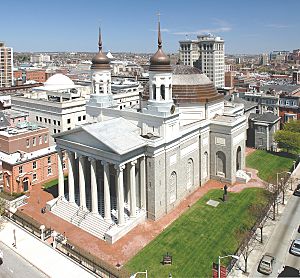
The Basilica in 2006
|
|
| Location | 409 Cathedral St. Baltimore, Maryland |
| Country | United States |
| Denomination | Roman Catholic Church |
| History | |
| Status | Co-cathedral, Minor basilica, National shrine, Parish church |
| Dedication | Assumption of the Blessed Virgin Mary |
| Consecrated | May 31, 1821 |
| Architecture | |
| Functional status | Active |
| Heritage designation | NRHP |
| Designated | October 1, 1969 |
| Years built | 1806–1821 2006 (restoration/renovation) |
| Specifications | |
| Number of domes | 1 |
| Number of spires | 2 |
| Bells | 2 (1831) |
| Administration | |
| Archdiocese | Baltimore |
| Province | Baltimore |
The Basilica of the National Shrine of the Assumption of the Blessed Virgin Mary, often called the Baltimore Basilica, is a Catholic cathedral in Baltimore, Maryland. It was the very first Catholic cathedral built in the United States after the country became independent. It was also one of the first big religious buildings constructed after the U.S. Constitution was adopted.
This important building serves as one of the main churches for the Catholic Archdiocese in Baltimore. It is also a local parish church, a minor basilica (a special church title), and a national shrine. Many people consider it the best work of Benjamin Henry Latrobe, who is known as the "Father of American Architecture."
Contents
History of America's First Cathedral
The Basilica was built between 1806 and 1821. It was designed by Benjamin Henry Latrobe, America's first professional architect. He also worked as Thomas Jefferson's architect for the U.S. Capitol building.
The construction was guided by John Carroll, the first American bishop of the Roman Catholic Church. The Basilica officially opened on May 31, 1821. It was later formally dedicated on May 25, 1876.
Important Events and People
Many significant events have happened inside the Basilica. For example, the funeral Mass for Charles Carroll of Carrollton took place here. He was the only Catholic person to sign the Declaration of Independence. He was also the last living signer.
Many of the first American bishops were consecrated (officially made bishops) at the Basilica. This was needed as the young country grew and more Catholic communities formed. For a long time, more priests were ordained here than in any other U.S. church.
The building also hosted many important meetings in the 1800s. These meetings helped shape the Catholic Church in America. They led to the creation of The Catholic University of America. They also encouraged efforts to share Catholicism with African and Native Americans. One large meeting, the Third Plenary Council, created the Baltimore Catechism. This was a book of Catholic teachings.
During the Civil War, in 1862, Union General Joseph Warren Revere visited the Basilica. He was so moved that he decided to become Catholic. He was baptized there on October 19, 1862.

Modern Recognition and Visitors
In 1937, Pope Pius XI gave the cathedral the special title of Minor Basilica. It was added to the National Register of Historic Places in 1969. Two years later, it became a National Historic Landmark. In 1993, it was named a National Shrine. The area around it is even called the Cathedral Hill Historic District.
Many important Catholic figures are connected to the Basilica. These include:
- Mother Mary Lange, who founded the first order of Catholic nuns for African-American women.
- Michael J. McGivney, who started the Knights of Columbus. He became a priest at the Basilica in 1877.
- St. John Neumann, who helped create America's Catholic school system.
The Basilica has welcomed millions of visitors over the years. This includes Pope John Paul II in 1995 and Mother Teresa in 1996. Many other saints or future saints have also visited.
On May 31, 2021, Archbishop William E. Lori celebrated the Basilica's 200th anniversary.
Building Design and Features
The Basilica is a huge building designed in the neoclassical style. This style uses ideas from ancient Greek and Roman buildings. It is shaped like a Latin cross when viewed from above. This was a new design for American churches at the time.
Outside the Basilica
The front of the building has a large Greek-style porch with Ionic columns. Behind these columns are two round towers. The unique onion-shaped domes on top of the towers were designed by Latrobe himself. The outside walls are made of silver-gray stone called gneiss, which came from a quarry nearby.
Inside the Basilica
Inside, a huge dome sits where the "arms" of the cross shape meet. This makes the center of the church feel very open. Around this main dome are other curved ceilings and smaller domes. Latrobe designed the inside to be full of light. This was different from older, darker Gothic cathedrals.
The Basilica also holds beautiful artworks. These include two large paintings given by King Louis XVIII of France after the church opened in 1821.
The Dome's Design
Latrobe first planned a stone dome. But his friend Thomas Jefferson suggested a wooden double-shell dome. This design had 24 hidden skylights. For the inner dome, Latrobe created a solid, classic-looking stone half-sphere. Its ceiling has decorative patterns called coffers with plaster flowers.
Restoration in the 2000s
A big restoration project finished in 2006. It cost $34 million and took 32 months. The goal was to update the building with modern systems. It also aimed to make the inside look like Latrobe's original design.
Many changes made over the years were undone. The original wall colors (pale yellow, blue, and rose) were brought back. The light-colored marble floor, which had been dark green, was also restored. The 24 skylights in the main dome were reopened. The stained glass windows from the 1940s were moved to another church. They were replaced with clear glass windows to let in more light.
The church's crypt (an underground burial place) was also opened to the public. The large basement area, called the undercroft, had been filled with sand. This sand was removed during the restoration. This allowed for the creation of the Our Lady Seat of Wisdom Chapel, which was part of the original plan.
Cardinal William Keeler, who was the Archbishop of Baltimore, helped lead the restoration. He raised private money for the project, so church funds were not used. The Basilica was closed from November 2004 to November 2006. It reopened just in time for its 200th anniversary.
The historic pipe organ has been rebuilt several times over the years. It was played in a concert in July 2024.
2011 Earthquake
On August 23, 2011, an earthquake shook the East Coast. It caused almost 1,000 feet of cracks in the Basilica's ceilings and walls. A $3 million repair project fixed the damage by Easter Sunday 2012.
Burial Place for Archbishops
Nine of the fourteen Archbishops of Baltimore who have passed away are buried in the Basilica's crypt. The crypt is located under the main altar, next to the Our Lady Seat of Wisdom Chapel. Visitors can access it.
Those buried there include:
- John Carroll, the first Bishop of the United States.
- James Cardinal Gibbons, a very important Archbishop of Baltimore.
- William Cardinal Keeler, who led the restoration project.
Special Designations
The Basilica of the Assumption was listed on the National Register of Historic Places in 1969. It became a National Historic Landmark in 1971. It is the main building in the Cathedral Hill Historic District. The Basilica is also part of the Baltimore National Heritage Area.
See also
 In Spanish: Basílica del Santuario Nacional de la Asunción de la Bienaventurada Virgen María para niños
In Spanish: Basílica del Santuario Nacional de la Asunción de la Bienaventurada Virgen María para niños
- List of churches in the Roman Catholic Archdiocese of Baltimore
- List of Catholic cathedrals in the United States
- List of cathedrals in the United States
- Top Catholic pilgrimage destinations in the US
Images for kids


